Whirlpool WFC7500VW0 User Manual
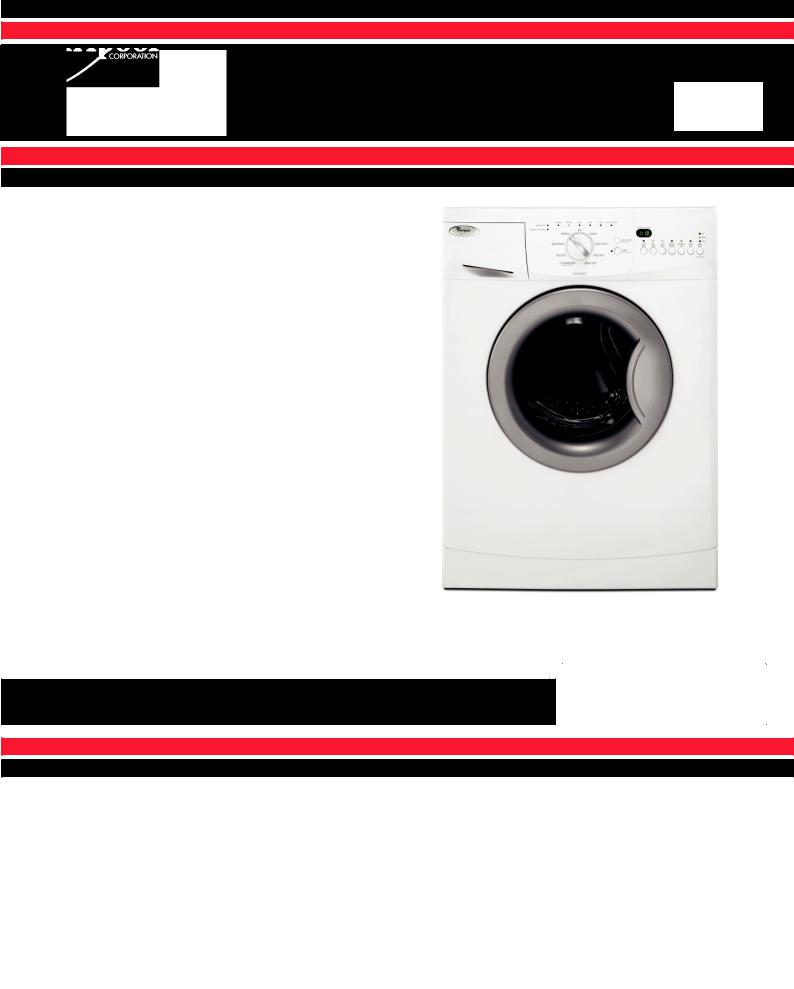
CONSUMER CARE TECHNICAL |
L-83 |
EDUCATION GROUP PRESENTS |
2008
24” FRONT-LOADING AUTOMATIC WASHER
Model WFC7500VW0
JOB AID
Part No. 8178738

FORWARD
This Whirlpool Job Aid, “2008 24" Front-Loading Automatic Washer” (Part No. 8178738), provides the In-Home Service Professional with information on the installation, operation, and service of the 2008 24" Front-Loading Automatic Washer. For specific information on the model being serviced, refer to the “Use and Care Guide,” or “Tech Sheet” provided with the washer.
The Wiring Diagram used in this Job Aid is typical and should be used for training purposes only.
Always use the Wiring Diagram supplied with the product when servicing the unit.
GOALS AND OBJECTIVES
The goal of this Job Aid is to provide information that will enable the In-Home Service Professional to properly diagnose malfunctions and repair the 2008 24" Front-Loading Automatic
Washer.
The objectives of this Job Aid are to:
•Understand and follow proper safety precautions.
•Successfully troubleshoot and diagnose malfunctions.
•Successfully perform necessary repairs.
•Successfully return the washer to its proper operational status.
WHIRLPOOL CORPORATION assumes no responsibility for any repairs made on our products by anyone other than In-Home Service Professionals.
Copyright © 2008, Whirlpool Corporation, Benton Harbor, MI 49022
- ii -
TABLE OF CONTENTS
Page GENERAL . . . . . . . . . . . . . . . . . . . . . . . . . . . . . . . . 1-1
Washer Safety. . . . . . . . . . . . . . . . . . . . . . . . . . . . . |
. |
1-1 |
Model & Serial Number Designations. . . . . . . . . . . . . . . . . . . . |
. |
1-2 |
Model & Serial Number Label And Tech Sheet Locations. . . . . . . . . . . . . |
|
1-3 |
Specifications . . . . . . . . . . . . . . . . . . . . . . . . . . . . . . 1-4 |
||
INSTALLATION INFORMATION . . . . . . . . . . . . . . . . . . . . . . . |
|
2-1 |
Installation Requirements. . . . . . . . . . . . . . . . . . . . . . . . . |
|
2-1 |
Installation Instructions. . . . . . . . . . . . . . . . . . . . . . . . . . |
|
2-6 |
PRODUCT OPERATION. . . . . . . . . . . . . . . . . . . . . . . . . . . 3-1 |
||
Features And Benefits. . . . . . . . . . . . . . . . . . . . . . . . . . |
. |
3-1 |
Washer Use. . . . . . . . . . . . . . . . . . . . . . . . . . . . . . |
. |
3-2 |
Washer Care. . . . . . . . . . . . . . . . . . . . . . . . . . . . . . 3-11 Troubleshooting. . . . . . . . . . . . . . . . . . . . . . . . . . . . . 3-14
COMPONENT ACCESS . . . . . . . . . . . . . . . . . . . . . . . . . . 4-1
Component Locations. . . . . . . . . . . . . . . . . . . . . . . . . . . 4-1 Removing The Console,The Touchpad/LED Assembly And Central Control Unit. . . . 4-2
Removing The Water Inlet Valve. . . . . . . . . . . . . . . . . . . . . . |
|
. |
4-4 |
Removing The Pressure Switch . . . . . . . . . . . . . . . . . . . . . . |
|
. |
4-5 |
Removing The Line Filter & Power Supply Cord. . . . . . . . . . . . . . . . |
|
. 4-6 |
|
Removing The Detergent Dispenser Assembly. . . . . . . . . . . . . . . . |
. |
|
4-8 |
Removing The Detergent Dispenser Motor. . . . . . . . . . . . . . . . . . |
|
. |
4-9 |
Removing The Door Switch Assembly And The Bellows. . . . . . . . . . . . . |
|
.4-11 |
|
Removing The Drain Pump. . . . . . . . . . . . . . . . . . . . . . . . |
|
4-14 |
|
Removing The ECO Valve. . . . . . . . . . . . . . . . . . . . . . . . |
. |
4-16 |
|
Removing The Motor Control Unit. . . . . . . . . . . . . . . . . . . . . |
. |
4-17 |
|
Removing The Temperature Sensor . . . . . . . . . . . . . . . . . . . . |
. |
4-19 |
|
Removing The Drive Belt And Motor. . . . . . . . . . . . . . . . . . . . |
. |
4-20 |
|
Removing The Basket Drive Pulley. . . . . . . . . . . . . . . . . . . . . |
|
4-22 |
|
Removing The Tub And Basket. . . . . . . . . . . . . . . . . . . . . . |
. |
4-23 |
|
COMPONENT TESTING . . . . . . . . . . . . . . . . . . . . . . . . . |
. |
|
5-1 |
Inlet Cold/Bleach Water Valve Solenoids . . . . . . . . . . . . . . . . . . |
. |
|
5-1 |
Inlet Hot Water Valve Solenoid. . . . . . . . . . . . . . . . . . . . . . |
. |
|
5-2 |
Pressure Switch. . . . . . . . . . . . . . . . . . . . . . . . . . . . . . . . . . . . . . . . . . . . . . . . . . . . . . . |
. |
. |
5-3 |
Line Filter. . . . . . . . . . . . . . . . . . . . . . . . . . . . . . . |
|
. |
5-4 |
Door Switch. . . . . . . . . . . . . . . . . . . . . . . . . . . . . . |
|
. |
5-5 |
Drain Pump. . . . . . . . . . . . . . . . . . . . . . . . . . . . . . . 5-6 |
|||
Temperature Sensor . . . . . . . . . . . . . . . . . . . . . . . . . . |
. |
|
5-7 |
Drive Motor. . . . . . . . . . . . . . . . . . . . . . . . . . . . . . |
|
. |
5-8 |
- iii -
Page
DIAGNOSTICS & TROUBLESHOOTING . . . . . . . . . . . . . . . . . . . . 6-1
Diagnostics. . . . . . . . . . . . . . . . . . . . . . . . . . . . . . . 6-1
Diagnostic Guide. . . . . . . . . . . . . . . . . . . . . . . . . . . |
. |
6-1 |
Failure Codes . . . . . . . . . . . . . . . . . . . . . . . . . . . . . 6-2 |
||
Diagnostic Test . . . . . . . . . . . . . . . . . . . . . . . . . . . . |
|
6-8 |
Universal Diagnostics Test . . . . . . . . . . . . . . . . . . . . . . . |
. |
6-9 |
Quick Diagnostic Test . . . . . . . . . . . . . . . . . . . . . . . . . .6-11 |
||
Electronic Assemblies - Removal Or Replacement. . . . . . . . . . . . . . |
6-12 |
|
Troubleshooting Guide. . . . . . . . . . . . . . . . . . . . . . . . . . 6-13 |
||
WIRING DIAGRAMS. . . . . . . . . . . . . . . . . . . . . . . . . . . . |
|
7-1 |
Washer . . . . . . . . . . . . . . . . . . . . . . . . . . . . . . . . |
|
7-1 |
- iv -
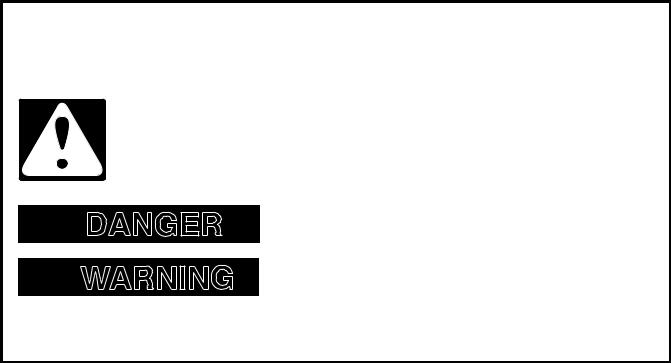
GENERAL
WASHER SAFETY
Your safety and the safety of others are very important.
We have provided many important safety messages in this manual and on your appliance.
Always read and obey all safety messages. This is the safety alert symbol.
This symbol alerts you to potential hazards that can kill or hurt you and others.
All safety messages will follow the safety alert symbol and either the word “DANGER” or “WARNING.” These words mean:
 DANGER
DANGER
 WARNING
WARNING
You can be killed or seriously injured if you don’t immediately follow instructions.
You can be killed or seriously injured if you don’t follow instructions.
All safety messages will tell you what the potential hazard is, tell you how to reduce the chance of injury, and tell you what can happen if the instructions are not followed.
1-1
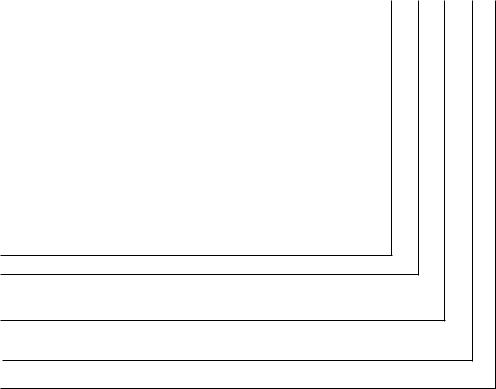
MODEL & SERIAL NUMBER DESIGNATIONS
MODEL NUMBER |
|
W |
|
F |
|
W |
|
7 |
|
5 00 V W 0 |
|
|
|
|
|
|
|||||||
BRAND |
|
|
|
|
|
|
|
|
|
|
|
W = WHIRLPOOL |
|
|
|
|
|
|
|
|
|
|
|
ACCESS |
|
|
|
|
|
|
|
|
|
|
|
F = Front Load |
T = Top LOAD |
|
|
|
|
|
|
|
|
|
|
|
|
|
|
|
|
|
|
|
|
|
|
PRODUCT |
|
|
|
|
|
|
|
|
|
|
|
W = WASHER |
|
|
|
|
|
|
|
|
|
|
|
SERIES |
|
|
|
|
|
|
|
|
|
|
|
5=Whirlpool Leap |
6=Oasis |
|
|
|
|
|
|
|
|
|
|
7=24" Front Load |
8=Mid Line Front Load |
|
|
|
|
|
|
|
|
|
|
9=Duet Front Load |
|
|
|
|
|
|
|
|
|
|
|
PRICE POINT LEVELS (1-9)
TRADE PARTNER ID (00 = BRANDED)
YEAR OF INTRODUCTION
V = 2008
COLOR CODE
T = Biscuit
ENGINEERING CHANGE (0, 1, 2, ETC.)
SERIAL NUMBER |
|
|
|
|
CK |
T |
41 |
01002 |
|
DIVISION RESPONSIBILITY |
|
|
|
|
C = CLYDE, OH K = SHANGHAI, CHINA |
|
|
|
|
YEAR OF PRODUCTION |
|
|
|
|
T = 2006 U = 2007 |
|
|
|
|
WEEK OF PRODUCTION |
|
|
|
|
41 = 41ST WEEK |
|
|
|
|
PRODUCT SEQUENCE NUMBER |
|
|
|
|
|
|
|
|
|
1-2
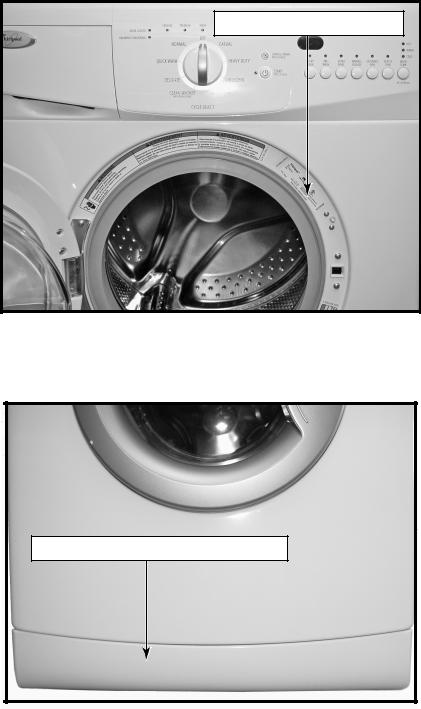
MODEL & SERIAL NUMBER LABEL
AND TECH SHEET LOCATIONS
The Model & Serial Number Label and Tech Sheet locations are shown below.
Model & Serial Number Label
Tech Sheet (Behind Lower Access Panel)
1-3
SPECIFICATIONS
Model Number |
WFC7500VW0 |
Model Description |
Front Load Washer |
Color |
White |
Capacity (IEC Equivalent) |
2.3 |
Temperature Control |
Thermist |
Heater |
No |
Sensors |
Suds Sensor, |
|
NTC (Thermistor), |
|
Water Level Sensor |
Tumble Speed |
Variable |
Spin Speed |
1200 RPM Maximum |
Motor |
Variable Speed; 1/3 HP |
Voltage |
120V |
Frequency |
60 Hz |
Amps |
15 Amp |
Water Consumption Average |
Variable per Load |
DOE (Gallons-Per-Cycle) |
CEE Tier II Qualified |
|
|
Height |
33.5" |
Install Depth: Min - Max |
23.5" |
Width |
23.5" |
1-4
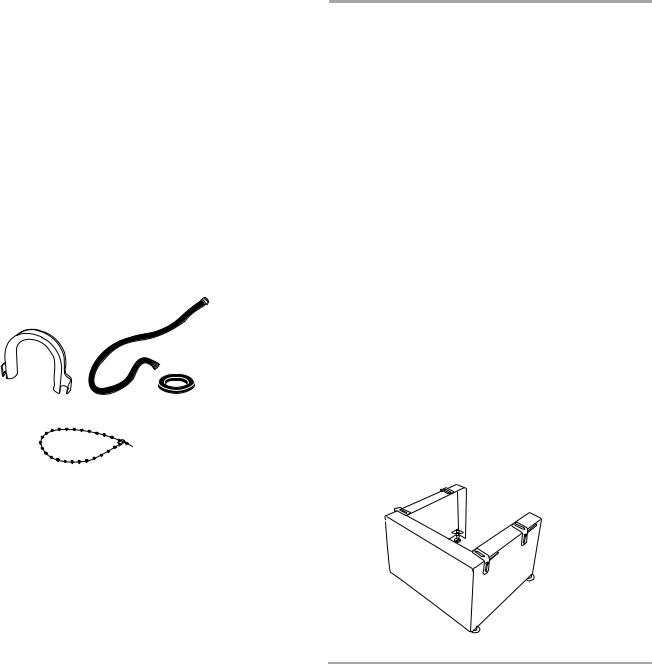
INSTALLATION INFORMATION
INSTALLATION REQUIREMENTS
TOOLS AND PARTS
Gather the required tools and parts before starting installation. The parts supplied are in the washer drum.
Tools needed for connecting the water inlet hoses
•Pliers (that open to 1-9/16˝ [39.5 mm])
•Flashlight (optional)
Tools needed for installation
•Open end wrenches 13 mm and 12 mm
•Level
•Wood block
•Ruler or measuring tape
Parts supplied
Alternate parts
If You Have |
You Will Need to Buy |
|
|
Laundry tub or |
Sump pump system (if not already |
standpipe taller |
available) |
than 55" (1.4 m) |
|
|
|
Overhead sewer |
Standard 20 gal. (76 L), 30" (76.2 cm) tall |
|
drain tub or utility sink and sump pump |
|
(available from local plumbing suppliers) |
|
|
Floor drain |
Siphon break, Part Number 285834; |
|
additional drain hose |
|
Part Number 8318155; and connector kit, |
|
Part Number 285835 |
|
|
Drain hose too |
4 ft (1.2 m) drain hose extension kit, |
short |
Part Number 285863 |
|
|
Water faucets |
2 longer water fill hoses: |
beyond reach of fill |
6 ft (1.8 m) Part Number 76314 |
hoses |
10 ft (3.0 m) Part Number 350008 |
|
|
A B C
D
A.U-shaped hose form
B.Water inlet hoses (2)
C.Inlet hose washers (4)
D.Beaded tie strap
OPTIONS
Pedestal
You have the option of purchasing pedestals of different heights separately for this washer. You may select a 11˝ (30.0 cm) pedestal. The pedestal will add to the total height of the washer.
Optional pedestal
Pedestal |
Approximate |
Color |
Model |
Height |
Height with |
|
Number |
|
Washer |
|
|
|
|
|
|
11.8" (30.0 cm) |
44.7" (113.5 cm) |
White |
LAB0050PQ |
|
|
|
|
2-1
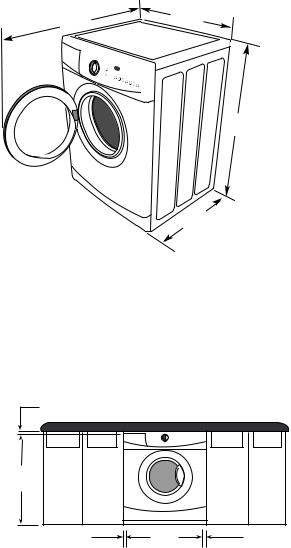
Stack Kit
Are you planning to stack your washer and dryer? To do so you will need to purchase a
Stack Kit.
To order, call the dealer from whom you purchased your washer or refer to the “Assistance or Service” section. Ask for Part Number W10178021.
LOCATION REQUIREMENTS
Selecting the proper location for your washer improves performance and minimizes noise and possible washer “walk.”
The washer can be installed under a custom counter, in a basement, laundry room, closet, or recessed area. See “Drain System,” page 2-4.
Companion appliance location requirements should also be considered. Proper installation is your responsibility.
You will need
•A water heater set to deliver 120°F (49°C) water to the washer.
•A grounded electrical outlet located within 5.4 ft (1.65 m) of where the power cord is attached to the back of the washer. See “Electrical Requirements,” page 2-5.
•Hot and cold water faucets located within 4 ft (1.2 m) of the hot and cold water fill valves, and water pressure of 20-100 psi
(137.9-689.6 kPa).
•A level floor with a maximum slope of
1˝(2.5 cm) under entire washer. Installing the washer on soft floor surfaces, such as carpets or surfaces with foam backing, is not recommended.
•A sturdy and solid floor to support the washer with a total weight (water and load) of 400 lbs (180 kg).
Do not operate your washer in temperatures below 32°F (0°C). Some water can remain in the washer and can cause damage in low temperatures.
Installation Clearances
•The location must be large enough to allow the washer door to be fully opened.
•Additional spacing should be considered for ease of installation and servicing. The door opens more than 90°, and it is not reversible.
•Additional clearances might be required for wall, door, and floor moldings.
•Additional spacing of 1˝ (2.5 cm) on all sides of the washer is recommended to reduce noise transfer.
•Companion appliance spacing should also be considered.
Washer Dimensions
36.2" |
23.4" |
|
(59.5 cm) |
||
(92 cm) |
||
|
32.9" (83.5 cm)
20.1"
(51cm)
Recommended installation spacing for custom undercounter installation
The dimensions shown are for the recommended spacing.
Custom undercounter installation - Washer only
2" (5 cm) |
|
|
32.9" min. |
|
|
(83.5 cm) |
|
|
1" |
23.4" |
1" |
(2.5 cm) |
(59.5 cm) |
(2.5 cm) |
2-2
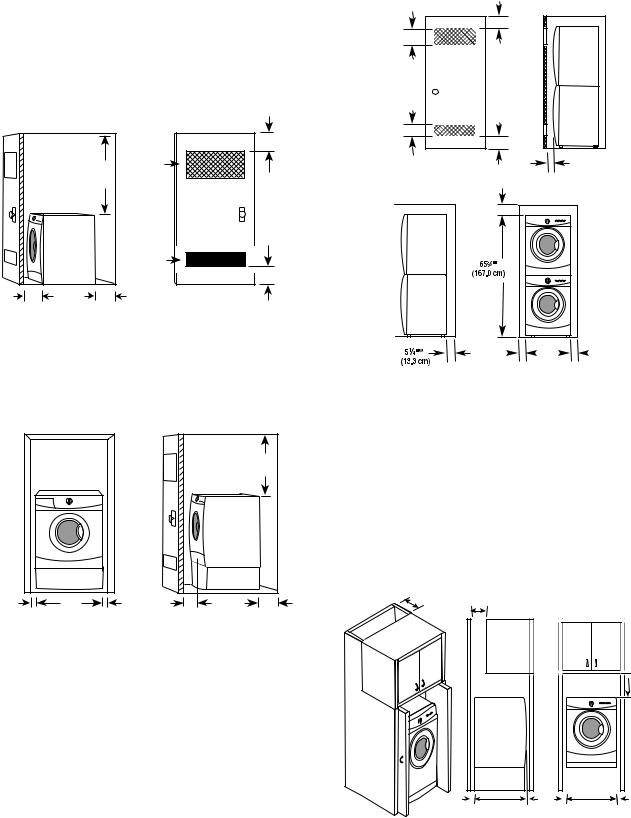
Recommended installation spacing for recessed or closet installation, with or without a pedestal
The dimensions shown are for the recommended spacing.
Recessed area or closet installation
|
|
|
|
3" |
|
|
|
|
(7.6 cm) |
|
|
34" |
48 in.2 |
|
|
|
(310 cm2) |
|
|
|
|
(86.4 cm) |
|
|
|
|
|
24 in.2 |
3" |
|
|
|
(155 cm2) |
|
|
|
|
|
(7.6 cm) |
1" |
20.1" |
4" |
|
|
(2.5 cm) |
(51.0 cm) |
(10.2 cm) |
|
|
|
A |
|
|
B |
A.Side view - closet or confined area
B.Closet door with vents
Recessed or closet installation - Washer on pedestal
1" |
23.4" |
1" |
(2.5 cm) |
(59.5 cm) |
(2.5 cm) |
|
|
18" min. |
|
|
(45.7 cm) |
1" |
20.1" |
4" |
(2.5 cm) |
(51.0 cm) |
(10.2 cm) |
A B
A.Recessed area
B.Side view - closet or con ned area
Recommended installation spacing for recessed or closet installation, with stacked washer and dryer
The dimensions shown, at the top of the right column, are for the recommended spacing.
48 in.2 *
(310 cm2)
3" (7.6 cm)
|
3" (7.6 cm) |
24 in.2 * |
1" (2.5 cm) |
(155 cm2) |
12" (30.5 cm) |
|
1" † |
|
|
|
23.4" |
|
|
|
1" † |
(2.5 cm) |
|
(59.5 cm) |
|
(2.5 cm) |
||||
*Min. top and bottom air openings for closet door. **External exhaust elbow requires additional space.
†Wall, door and oor molding may require additional spacing.
Recommended installation spacing for cabinet installation
The dimensions shown are for the recommended spacing.
For cabinet installation with a door, the minimum ventilation openings in the top are required.
7" (17.8 cm) |
7" (17.8 cm) |
|
|
|
|
|
|
|
 9"
9"
(22.9 cm)
|
|
|
|
|
|
|
|
|
|
|
|
|
|
|
|
|
|
|
|
|
|
|
|
|
|
|
|
|
|
|
|
|
|
|
|
|
|
|
|
|
|
|
|
|
|
|
|
|
|
|
|
|
|
|
|
|
|
|
|
|
|
|
|
|
|
|
|
|
|
|
|
|
|
|
|
|
|
|
|
|
|
|
|
|
|
|
|
|
|
|
|
|
|
|
|
4" |
20.7" |
1" |
1" |
23.4" |
1" |
||||||
|
(10.2 cm) (52.5 cm) (2.5 cm) |
(2.5 cm) (59.5 cm) (2.5 cm) |
|||||||||
2-3
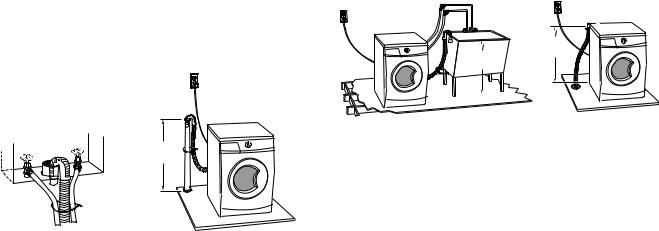
DRAIN SYSTEM
The washer can be installed using the standpipe drain system (floor or wall), the laundry tub drain system or the floor drain system.
Select the drain hose installation method you need. See “Tools and Parts,” page 2-1.
Standpipe drain system - wall or floor (views A & B)
The standpipe drain requires a minimum diameter standpipe of 2˝ (5 cm). The minimum carry-away capacity can be no less than
17 gal. (64 L) per minute.
The top of the standpipe must be at least 30˝
(76.2 cm) high and no higher than 55˝ (1.4 m) from the bottom of the washer.
Laundry tub drain system (view C)
The laundry tub needs a minimum 20 gal.
(76 L) capacity. The top of the laundry tub must be at least 30˝ (76.2 cm) above the floor.
Floor drain system (view D)
The floor drain system requires a siphon break that may be purchased separately. See “Tools and Parts,” page 2-1.
The siphon break must be a minimum of 26˝
(66 cm) from the bottom of the washer. Additional hoses might be needed.
|
26" min. |
30" min. |
(66 cm) |
(76.2 cm) |
|
C D
30" min. 

 (76.2 cm)
(76.2 cm) 
A B
2-4
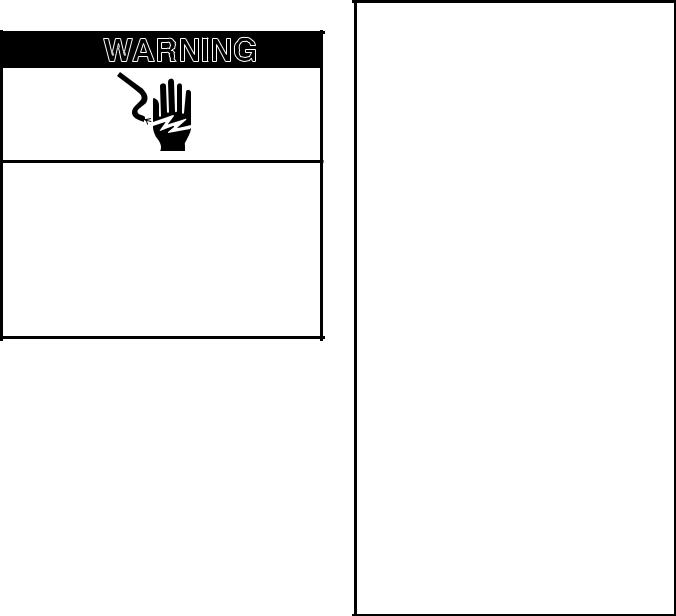
ELECTRICAL REQUIREMENTS
 WARNING
WARNING
Electrical Shock Hazard Plug into a grounded 3 prong outlet. Do not remove ground prong.
Do not use an adapter.
Do not use an extension cord.
Failure to follow these instructions can result in death, fire, or electrical shock.
•A 120 volt, 60 Hz., AC only, 15or 20amp, fused electrical supply is required. A time-delay fuse or circuit breaker is recommended. It is recommended that a separate circuit serving only this appliance be provided.
•This washer is equipped with a power supply cord having a 3 prong grounding plug.
•To minimize possible shock hazard, the
cord must be plugged into a mating, 3 prong, grounding-type outlet, grounded in accordance with local codes and ordinances. If a mating outlet is not available, it is the personal responsibility and obligation of the customer to have the properly grounded outlet installed by a qualified electrician.
•If codes permit and a separate ground wire is used, it is recommended that a qualified electrician determine that the ground path is adequate.
•Do not ground to a gas pipe.
•Check with a qualified electrician if you are not sure the washer is properly grounded.
•Do not have a fuse in the neutral or ground circuit.
GROUNDING INSTRUCTIONS
For a grounded, cord-connected washer:
This washer must be grounded. In the event of a malfunction or breakdown, grounding will reduce the risk of electrical shock by providing a path of least resistance for electric current. This washer is equipped with a cord having an equip- ment-grounding conductor and a grounding plug. The plug must be plugged into an appropriate outlet that is properly installed and grounded in accordance with all local codes and ordinances.
WARNING: Improper connection of the equipment-grounding conductor can result in a risk of electric shock. Check with a qualified electrician or serviceman if you are in doubt as to whether the appliance is properly grounded.
Do not modify the plug provided with the appliance – if it will not fit the outlet, have a proper outlet installed by a qualified electrician.
For a permanently connected washer:
This washer must be connected to a grounded metal, permanent wiring system, or an equipment-grounding conductor must be run with the circuit conductors and connected to the equipment-grounding terminal or lead on the appliance.
2-5

INSTALLATION INSTRUCTIONS
REMOVE TRANSPORT SYSTEM
 WARNING
WARNING
Excessive Weight Hazard
Use two or more people to move and install washer.
Failure to do so can result in back or other injury.
IMPORTANT: Position the washer so that the rear of the unit is within approximately 3 ft
(90 cm) of the final location.
There are 4 bolts in the rear panel of the washer that support the suspension system during transportation. These bolts also retain the power cord inside the washer until the bolts are removed.
1.Using a 12 mm wrench, loosen each of the bolts.
2.Once the bolt is loose, move it to the center of the hole and completely pull out the bolt, including the plastic spacer covering the bolt.
3.Once all 4 bolts are removed, discard the bolts and spacers. Then pull the power cord through the opening of the rear panel and close the hole with the attached cap.
4.Close the bolt holes with the 4 transport bolt hole plugs.
NOTE: If the washer is to be transported at a later date, call your local service center.
To avoid suspension and structural damage, your machine must be properly set up for relocation by a certified technician.
CONNECT THE INLET HOSES
Insert new flat washers (supplied) into each end of the inlet hoses. Firmly seat the washers in the couplings.
AB
A.Coupling
B.Washer
Connect the inlet hoses to the water faucets
Make sure the washer drum is empty.
1.Attach a hose to the hot water faucet.
Screw on coupling by hand until it is seated on the washer.
2.Attach a hose to the cold water faucet.
Screw on coupling by hand until it is seated on the washer.
3.Using pliers, tighten the couplings with an additional two-thirds turn.
NOTE: Do not overtighten or use tape or sealants on the valve. Damage to the valves can result.
2-6
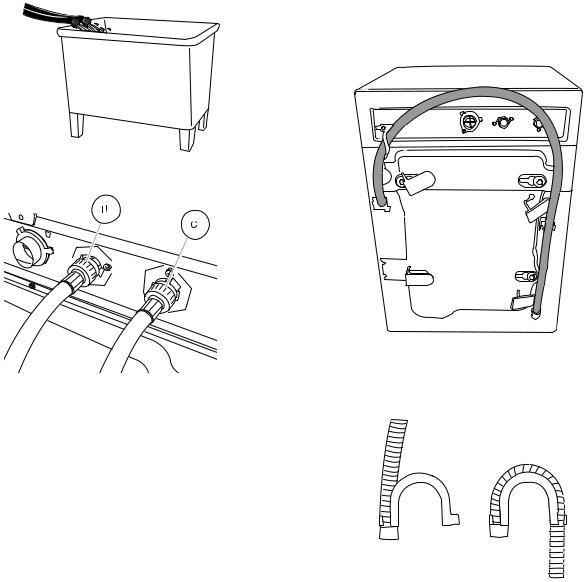
Clear the water lines
1.Run water through both faucets and inlet hoses, into a laundry tub, drainpipe or bucket, to get rid of particles in the water lines that might clog the inlet valve screens.
2.Check the temperature of the water to make sure that the hot water hose is connected to the hot water faucet and that the cold water hose is connected to the cold water faucet.
Connect the inlet hoses to the washer
H. Hot water inlet
C.Cold water inlet
1.Attach the hot water hose to the washer’s hot (H) water inlet valve. Screw on coupling by hand until it is seated on the washer.
2.Attach the cold water hose to the washer’s cold (C) water faucet. Screw on coupling by hand until it is seated on the washer.
3.Using pliers, tighten the couplings with an additional two-thirds turn.
NOTE: Do not overtighten. Damage to the coupling can result.
4.Turn on the water faucets completely and check for leaks.
NOTE: Replace inlet hoses after 5 years of use to reduce the risk of hose failure. Record hose installation or replacement dates on the hoses for future reference.
Periodically inspect and replace hoses if bulges, kinks, cuts, wear, or leaks are found.
ROUTE THE DRAIN HOSE
Proper routing of the drain hose protects your floors from damage due to water leakage. Read and follow these instructions.
Remove drain hose from the washer
Gently pull the corrugated drain hose from the shipping clips.
Laundry tub drain or standpipe drain
Connect the drain hose form to the corrugated drain hose.
AB
A.Snap either end of the drain hose form to the drain hose at the point where the corrugation begins.
B.Bend drain hose over drain hose form and snap into place.
2-7
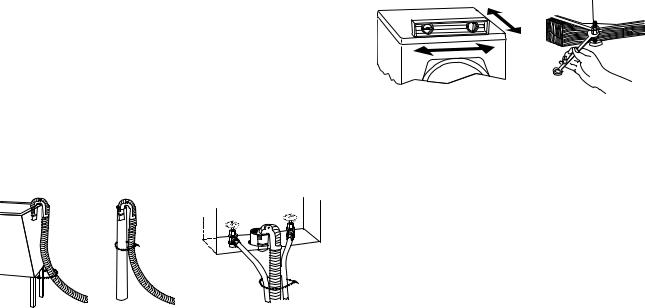
To keep drain water from going back into the washer:
•Do not straighten the drain hose, and do not force excess drain hose into standpipe.
Hose should be secure, but loose enough to provide a gap for air.
•Do not lay excess hose on the bottom of the laundry tub.
Floor drain
You may need additional parts. See Floor
Drain under “Tools and Parts,” page 2-1.
SECURE THE DRAIN HOSE
1.Drape the power cord over the washer top.
2.Move the washer to its final location.
3.Place the drain hose in the laundry tub or standpipe. See illustrations A and B.
A B C
4.If the washer faucets and the drain standpipe are recessed, put the hooked end of the drain hose in the standpipe. See illustration C.
NOTES:
•Do not force excess drain hose back into the rear of the washer.
•To prevent siphoning, do not seal the drain hose into the standpipe.
LEVEL THE WASHER
Properly leveling your washer avoids excessive noise and vibration.
1.Check the levelness of the washer by placing a level on the top edge of the washer, first side to side, then front to back.
If the washer is against a wall, move the washer out slightly before tipping back. First prop the front with a wood block and adjust the feet as necessary; then prop the back and adjust feet as necessary. Repeat this step until washer is level.
2.Make sure that all four feet are stable and resting on the floor. Then check that the appliance is perfectly level (use a level).
3.After the washer is level, use a 13 mm open-end wrench to turn the nuts on the feet tightly against the washer cabinet.
IMPORTANT: All four feet must be tightened. If the nuts are not tight against the washer cabinet, the washer may vibrate.
4.Slide the washer to its final location.
5.The washer should not move front to back, side to side, or diagonally when pushed on its top edges.
6.Confirm the levelness of the washer.
2-8
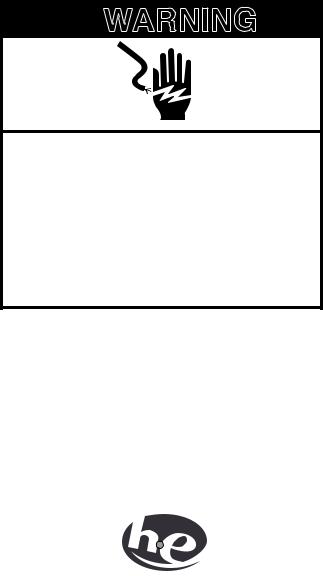
COMPLETE INSTALLATION
1.Check the electrical requirements. Be sure that you have the correct electrical supply and the recommended grounding method. See “Electrical Requirements,” page 2-5.
2.Check to be sure all parts are now installed. If there is an extra part, go back through the steps to see which step was skipped.
3.Check that you have all of your tools.
4.Dispose of or recycle all packaging materials.
5.Check that the water faucets are on.
6.Check for leaks around faucets and inlet hoses.
 WARNING
WARNING
Electrical Shock Hazard Plug into a grounded 3 prong outlet. Do not remove ground prong.
Do not use an adapter.
Do not use an extension cord.
Failure to follow these instructions can result in death, fire, or electrical shock.
7.Plug into a grounded 3 prong outlet.
8.Read “Washer Use,” page 3-2.
9.To test and to clean your washer, use 1/2 the manufacturer’s recommended amount of detergent for a medium sized load. Pour the detergent into the detergent dispenser. Select NORMAL/CASUAL, and then select START. Allow the washer to complete one whole cycle.
Use only HE High Efficiency detergent.
2-9
— NOTES —
2-10

PRODUCT OPERATION
FEATURES AND BENEFITS
The front-loading high efficiency washer was designedtoconserveresourcesandloweryour waterandenergybills.Thewasherisdesigned to determine and then provide the amount of water needed for the best performance. The time of operation may be greater for this new system than for a conventional washer.
ELECTRONIC CONTROLS
Flexible electronic controls are easy to use whether you are a beginner or an expert.
AUTO WATER LEVEL
Adjusting to the size of the load, this feature allows the washer to use the minimal amount ofwaterneededtocleanandrinsetheclothes. With a low water level, you can obtain the sameresultswithsmalleramountsofadditives. Because only the required amount of water is used, the washer saves energy, too. You can obtain the same washing results for small and large loads size.
SUSPENSION SYSTEM
To reduce washer “walk” and “off-balance” conditions, your new washer combines:
•2 Springs to isolate vibration
•2 shock absorbers at the washer base to minimize movement
SPIN SPEEDS
This washer automatically selects the spin speed based on the cycle selected.
DYNAMIC BALANCE
Aprecisionbalancingsystemallowsthewasher to reach high-speed spins. The washer spins fastersothatclothescomingoutofthewasher willhavelessmoisturethanwithtraditionaltop loadmachines.Inaddition,iftheDynamicBalance system detects off-balance loads during spinning,itredistributestheclothessothatthey are evenly balanced.
Smart Dispensers
The three compartments in the dispenser allow loading of all laundry products before the washer is started. The products will be dispensed into the wash at the optimal time for high performance cleaning. The bleach release system is included in the detergent advantage system. The detergent is added at the beginning of the cycle, and the bleach is added after the enzymes have had a chance to do their cleaning. The fabric softener is dispensed in the rinse cycle or in the EXTRA RINSE, if selected. The Detergent Advantage System Dispenser tray is easily removed for cleaning.
STAINLESS STEEL DRUM
The stainless steel drum eliminates corrosion andenableshigherspinspeedsformorewater extraction, reducing drying time.
ADAPTIVE VARIABLE SPEED MOTOR
The motor adapts to the load size and to the cycle selected to give the optimum cleaning, rinsing,andspinningconditions.Themotorcan handle slow speeds needed for delicate items and is powerful enough to drive an average clothes load up to a high-speed spin.
Use only HE High Efficiency detergent.
3-1
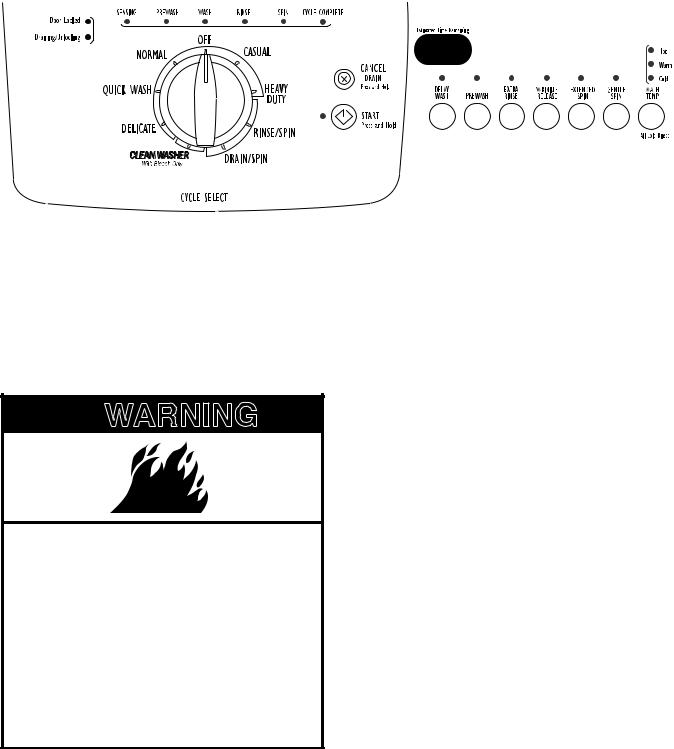
WASHER USE
STARTING THE WASHER
 WARNING
WARNING
Fire Hazard
Never place items in the washer that are dampened with gasoline or other flammable fluids.
No washer can completely remove oil.
Do not dry anything that has ever had any type of oil on it (including cooking oils).
Doing so can result in death, explosion, or fire.
The following is a guide to using the washer. Pleaserefertospecificsectionsofthismanual for more detailed information.
Do not store laundry products on the top surface of this washer. Vibration is normal during operation.
3-2

USING THE PROPER DETERGENT
UseonlyHighEfficiencydetergents.Thepackage for this type of detergent will be marked
“HE” or “High Efficiency.” This wash system, along with less water, will create too much sudsing with a regular non-HE detergent. Usingregulardetergentwilllikelyresultinwasher errors,longercycletimes,andreducedrinsing performance. It may also result in component failuresandnoticeablemoldormildew.HEdetergentsaremadetoproducetherightamount of suds for the best performance. Follow the manufacturer’s instructions to determine the amount of detergent to use.
Use only HE High Efficiency detergent.
First Wash Cycle Without Laundry
Before washing clothes for the first time, if not completed during the final installation step, choose the Normal/Casual cycle and run it without clothes. Use only HE High Efficiency detergent. Use 1/2 the manufacturer’s recom- mendedamountforamedium-sizedload.This initialcycleservestoensuretheinteriorisclean before washing clothes.
For All Wash Cycles
1.To load washer
Open the washer door by pulling on the handle.Sortlaundryaccordingtocolorand typeoffabric.Placealoadofsortedclothes in the washer. Do not overload washer. Overloading can cause poor cleaning.
•The washer can be fully loaded, but not tightly packed. Washer door should close easily.
•Mix large and small items.Avoid washing a single item. Load evenly.
•Wash small items such as infant socks inmeshgarmentbags.Itisrecommended that more than one garment bag be used and that each garment bag be filled with equal amounts of material.
•Whenunloadinggarments,occasionally
check under the rubber rim at the front of the tub for small items.
2.Closethewasherdoorbypushingitfirmly until the lock clicks. The washer door will remain locked during the wash cycle.
NOTE: Thereisaroutineatthebeginning of each cycle to avoid unintended use of the washer.This routine will take approximately 1 minute to complete before the selected wash cycle begins.
3.Openthedispenserdrawerandaddlaundry additives to the detergent, bleach, or fabric softener compartments. Close drawer slowly to avoid spills. See “Using the Dispenser.”
4.Turn on the washer by turning the cycle selector and selecting one of the cycles. The indicator light for the selected cycle will illuminate. When selecting a Wash Cycle, the preset Modifiers, Options and Water Temp for the selected cycle will illuminate. The preset settings provide the recommendedfabriccarefortheselected cycle. See “Cycles.”
5.Select the desired OPTIONS. Not all Options are available with all cycles. See “Options.”
6.To begin the wash cycle immediately
SelectandholdSTART(forapproximately 3 seconds).
•If you do not select START within 5 minutesofchoosingacycle,thewasher display automatically shuts off.
•When the wash cycle is complete, the
CYCLE COMPLETE status light illuminates, the door unlocks and the wash load can be removed from the washer. The washer goes into standby mode automatically after the door is opened or1hourafterthecycleiscompleteand all displays will go off.
•To power down the washer manually afterthewashcycleiscomplete,switch knob to Off position.
3-3
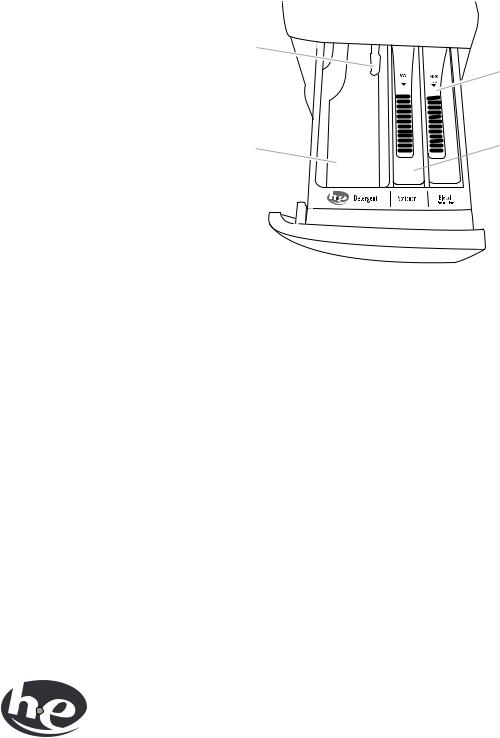
7.To begin the wash cycle later Select
DELAYWASHuntilthedesireddelaytime
(inhours)isdisplayed.SelectSTART.The countdown to the wash cycle will show in the display window.
IMPORTANT: Whendelayingacycle,use onlypowdereddetergentsinthemainwash compartment since liquid detergents may seepoutofthecompartmentduringDelay before the wash cycle begins.
USING THE DISPENSER
The washer has a dispenser drawer with three separate compartments for your laundry additives—one is for detergent, one is for liquid chlorine bleach, and one is for liquid fabric softener. Laundry additives are diluted and dispensed automatically at the proper time during the wash cycle, making it unnecessary for you to return to the washer during the cycle to add them.
It is normal for small amounts of water to remain in the dispensers when the wash cycle is complete.
Do not put laundry additives directly into the wash tub. Always use the proper dispensers when adding laundry additives.
Choosing the Right Detergent
UseonlyHighEfficiencydetergents.Thepackage for this type of detergent will be marked “HE” or “High Efficiency.” This wash system, along with less water, will create too much sudsing with a regular non-HE detergent. Usingregulardetergentwilllikelyresultinwasher errors,longercycletimes,andreducedrinsing performance. It may also result in component failuresandnoticeablemoldormildew.HEdetergentsaremadetoproducetherightamount of suds for the best performance. Follow the manufacturer’s instructions to determine the amount of detergent to use.
To fill dispenser compartments
1.Pull out the dispenser drawer.
2.Add the desired laundry products to the proper compartment.
3.Push in the dispenser drawer slowly and completely (to avoid a spill).
A
C
B 
 D
D
Dispenser
A.Dispenser release lever
B.Main Wash detergent compartment
C.Liquid chlorine bleach compartment
D.Fabric softener compartment
Main Wash detergent compartment
(Letter B in Dispenser Illustration)
Add liquid or powdered HE detergent to this compartment for your main wash cycle.
•Powdered color-safe bleach may be added to the Main Wash compartment along with the powdered detergent.
Use only HE High Efficiency detergent.
3-4

•Follow the manufacturer’s instructions to determine the amount of detergent to use.
NOTE: Overfillingcouldcauseanoversudsing condition.
Chlorine bleach compartment
(Letter C in Dispenser Illustration)
Add NO MORE THAN 1/2 cup (120 mL) liquid chlorinebleachtothiscompartment.Thebleach will be automatically diluted and dispensed at the best time during the first rinse after the wash cycle. This compartment cannot dilute powdered bleach.
•Use only liquid chlorine bleach in this dispenser. Do not use this dispenser to add powdered chlorine or any form of colorsafe bleach to your load.
•Always measure liquid chlorine bleach. Use a measuring cup with a pour spout; do not guess. Follow the manufacturer’s directions for proper use.
•Do not fill beyond the “MAX” level.
NOTE: Overfilling could cause garment damage.
Fabric softener compartment
(Letter D in Dispenser Illustration)
Add 1/2 cup (120 mL) liquid fabric softener to this compartment. Fabric softener will be automatically dispensed in the final rinse or in the EXTRA RINSE, if selected.
• Do not fill beyond the “MAX” level.
RESTARTING
To restart the washer at any time, select CANCEL/DRAIN.
CHANGING CYCLES AND OPTIONS
Not all Options are available with all Cycles.
Cycles and Options can be changed anytime before START is selected.
To stop a cycle and select a new cycle
1.Press and hold CANCEL/DRAIN for 3 seconds.
2.Select desired cycle..
3.Select the desired OPTIONS.
4.SelectandholdSTART(forapproximately
3 seconds) to restart the washer at the beginning of the new cycle.
To cancel a cycle and to drain the washer manually
1.Press and hold CANCEL/DRAIN for 3 seconds.
2.Thepumpwillturnontodrainoutthewater and the door will unlock.
NOTE: t will take approximately 1 minute for the door to unlock.
3.The washer cycle stops, the door unlocks and clothes can be removed.
4.To power down the washer manually after the wash cycle is complete, switch knob to Off position.
NOTE: If the water level is too high, the washer will drain automatically before the door unlocks.
.
STATUS LIGHTS
These lights show which portion of the cycle the washer is operating.
3-5
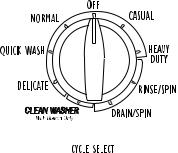
Sensing
The washer automatically weighs items then adjusts the EstimatedTime Remaining, based on the cycle selected.
Cycle Complete
The Cycle Complete status light stays on for 1 hourafterthecycleiscomplete.Topowerdown the washer manually after the wash cycle is complete, switch knob to Off position.
Estimated Time Remaining
The cycle times vary automatically based on your water pressure, water temperature, detergent, and clothes load. The cycle time will be extended if oversudsing occurs or the load is unbalanced. The oversuds routine removes extra suds and assures proper rinsing of your garments. The options you select will also affect the cycle times that are shown in the Preset Cycle Settings table. The Estimated Time Remaining can change to much longer times under extreme conditions.
Door Locked
When the Door Locked LED light illuminates, the door is locked. The door is locked and unlocked automatically, depending on the stage of the wash cycle. Press and hold CANCEL/ DRAINfor3secondstounlockthedoormanually. It will take approximately 1 minute for the door to unlock..
Cycles
Wash Cycles
ChooseWashCyclesbyrotatingtheCycleselector knob to the desired cycle. The indicator lightforthecycleselectedwillilluminate.Each cycle is designed for different types of fabric and soil levels.
•Each cycle has a default cycle time, WASH
TEMP, and may have preset Options. The preset settings provide the recommended fabric care for the selected cycle.
•Thepresetsettingscanbechangedanytime before START is selected. Not all Options and Modifiers (WASH TEMP, spin options) are available with all Cycles. Select and hold START (for approximately 3 seconds) to continue the cycle.
3-6

Preset Cycle Settings
EachcyclehasapresetCycleTimeandWASH/
RINSE TEMP. The preset settings provide the recommended fabric care for the selected cycle. See chart..
Cycle |
Estimated |
Wash Temp |
Spin Speed |
|
Time* |
|
|
|
(hr:min) |
|
|
|
|
|
|
Normal |
0:50 |
Warm |
High |
|
|
|
|
Quick Wash |
0:30 |
Warm |
High |
(2-3 items) |
|
|
|
|
|
|
|
Delicate |
0:37 |
Warm |
Low |
|
|
|
|
Clean Washer |
1:15 |
Hot |
High |
|
|
|
|
Drain/Spin |
0:18 |
N/A |
High |
|
|
|
|
Rinse/Spin |
0:24 |
Cold |
High |
|
|
|
|
Heavy Duty |
1:10 |
Warm |
High |
|
|
|
|
Casual |
0:45 |
Warm |
Low |
|
|
|
|
*The cycle times vary automatically based on your water pressure, water temperature, detergent, and clothes load. The cycle time willbeextendedifoversudsingoccursorthe load is unbalanced.
Normal
Usethiscycletowashloadsofnormallysoiled cottons and linens. This cycle has high-speed spin.
Quick Wash
Usethiscycletowashsmallloadsof2-3lightly soiled garments that are needed in a hurry. This cycle combines a shortened wash time and high-speed spin to shorten drying time. Large wash loads will result in the machine increasing the wash time.
Delicate
Use this cycle to wash sheer fabrics and lingerie.This cycle has low-speed spin forgentle fabric care.
•Use mesh garment bags to wash undergarments such as underwire bras, items with strings, and small items such as socks.
Clean Washer
Use the Clean Washer cycle once a month to keeptheinsideofyourwasherfreshandclean.
This cycle uses a higher water level. Use with
AFFRESH™ washer cleaner tablet or liquid chlorine bleach to thoroughly clean the inside ofyourwashingmachine.Thiscycleshouldnot be interrupted. See “Cleaning Your Washer.”
Drain/Spin
Use this cycle to drain your washer or to drain and spin your wash load. The spin speed is preset to HIGH.
Rinse/Spin
Usethiscycletogetarinseandspinonly.This cycle has highspeed spin.
Rinse & Spin is useful for:
•Loads that need rinsing only.
•Adding fabric softener to a load using the fabric softener dispenser
3-7
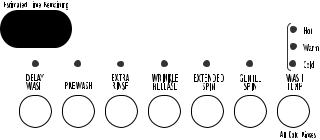
Heavy Duty
Usethiscycletowashloadsofsturdy,colorfast fabrics and Heavy soiled garments.This cycle combines a longer wash time and high-speed spin to shorten drying times.
Casual
Use this cycle to wash loads of permanent press blends and synthetic fabrics. This cycle has a load cooling process to reduce wrinkling.
NORMAL SOUNDS
As with any new product, you will hear sounds that you are not accustomed to. You may hear various sounds when the door is locked or unlocked, and during the washing, rinsing, or spinning process. Between changes in wash actions, there will be momentary pauses. You will hear water spraying and splashing during the wash and rinse cycles.These new sounds and pauses are part of normal washer operation. See “Troubleshooting.”
OPTIONS AND MODIFIERS
You can customize your wash by adding options to your cycle selections. Not all Options are available with all cycles.
•See the “Laundry Guide” section for an overview of possible options for each Wash Cycle selection.
•Ifanoptionisavailablewithaselectedcycle, the light for that option will illuminate when selected.
•If an option is unavailable with a selected cycle, there will be a blinking light. The light for that option will not illuminate when selected.
Delay Wash
Use this to begin the wash cycle later.
•Select DELAY WASH until the desired time (in hours) shows in the Estimated Time Remaining display.
•Select START. The countdown to the wash cycle will show in the display window.
3-8

Prewash
Prewash is an 18-minute soak phase that is addedbeforethemainwash.Duringprewash, there is only a small amount of tumbling.
Extra Rinse
Anextrarinsecanbeusedtoaidintheremoval of detergent or bleach residue from garments.
This option provides an additional rinse with the same water temperature as in the normal rinse. You may select or deselect by pressing
EXTRA RINSE.
Wrinkle Release
Use this option to increase the quantity of incoming water and decrease the spin speed and duration in the rinse period. The last spin phase will have a lower spin speed and last a shorter time.
Extended Spin
Usethisoptiontoincreasethefinalspinperiod by 1 minute during the final spin.
Gentle Spin
Eachcyclehasapresetspinspeed.Toreduce the final spin speed, select the GENTLE SPIN button.
Wash Temp
Each cycle has a preset water temperature setting. To change the water temperature, select the WASH TEMP button until the desired setting is illuminated.
Select a water temperature based on the type of load you are washing. Use the warmest wash water safe for fabrics. Follow garment label instructions.
The water temperature for all rinse cycles is cold. Cold rinses save energy.
Temperature Guide
Temperature Guide
Wash Water Temperature |
Suggested Fabrics |
|
|
HOT |
Whites and pastels |
|
Heavy soils |
|
|
WARM |
Bright colors |
|
Moderate to light soils |
|
|
COLD |
Colors that bleed or fade |
|
Light soils |
|
|
In wash water temperatures colder than 60°F
(15.6°C),detergentsdonotdissolvewell.Soils may be difficult to remove.
Auto Temp Control
ATC(AutoTempControl)electronicallysenses and maintains a uniform water temperature. ATC regulates incoming hot and cold water.
The ATC is automatically turned ON when a cycle is selected. See Preset Cycle Settings table in “Cycles.”
•ATC works for the wash temperature with Warm and Cold settings.
•The Cold rinse temperatures depend on the cold water at the faucet.
3-9
